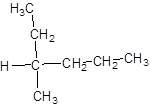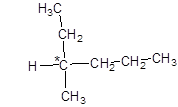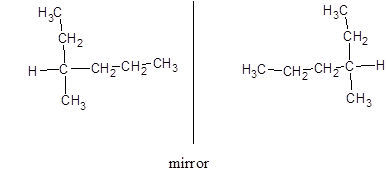
Interpretation:
Two different optical isomers needs to be drawn by attaching the following atoms or groups to the carbon atom:
Concept introduction:
Two mirror image representations are possible for a molecule having chiral center in its structure. If the mirror images are non-superimposable to each other then, they are said to be optical isomers.
Explanation of Solution
A molecule is said to be chiral molecule when all the attached groups to central carbon atom are different and lacks in plane of symmetry in the molecule. The molecules having chiral centres show optical isomerism as there are two mirror image representations possible for a molecule having chiral center in its structure and if the mirror images are non-superimposable to each other then, they are said to be optical isomers.
Now, starting from a single carbon atom, two different optical isomers can be drawn by attaching
The single compound formed will be:

Since the central carbon atom is attached to four different atoms and groups so, it is chiral in nature shown by * as:

Now, drawing the optical isomers using mirror as:

Since, the mirror image is not superimposable to each other so, they are optical isomers of each other.
Chapter 21 Solutions
Glencoe Chemistry: Matter and Change, Student Edition
Additional Science Textbook Solutions
Inorganic Chemistry
Organic Chemistry (9th Edition)
Organic Chemistry
Chemistry: The Central Science (13th Edition)
Chemistry: The Central Science (14th Edition)
Chemistry: A Molecular Approach (4th Edition)
 ChemistryChemistryISBN:9781305957404Author:Steven S. Zumdahl, Susan A. Zumdahl, Donald J. DeCostePublisher:Cengage Learning
ChemistryChemistryISBN:9781305957404Author:Steven S. Zumdahl, Susan A. Zumdahl, Donald J. DeCostePublisher:Cengage Learning ChemistryChemistryISBN:9781259911156Author:Raymond Chang Dr., Jason Overby ProfessorPublisher:McGraw-Hill Education
ChemistryChemistryISBN:9781259911156Author:Raymond Chang Dr., Jason Overby ProfessorPublisher:McGraw-Hill Education Principles of Instrumental AnalysisChemistryISBN:9781305577213Author:Douglas A. Skoog, F. James Holler, Stanley R. CrouchPublisher:Cengage Learning
Principles of Instrumental AnalysisChemistryISBN:9781305577213Author:Douglas A. Skoog, F. James Holler, Stanley R. CrouchPublisher:Cengage Learning Organic ChemistryChemistryISBN:9780078021558Author:Janice Gorzynski Smith Dr.Publisher:McGraw-Hill Education
Organic ChemistryChemistryISBN:9780078021558Author:Janice Gorzynski Smith Dr.Publisher:McGraw-Hill Education Chemistry: Principles and ReactionsChemistryISBN:9781305079373Author:William L. Masterton, Cecile N. HurleyPublisher:Cengage Learning
Chemistry: Principles and ReactionsChemistryISBN:9781305079373Author:William L. Masterton, Cecile N. HurleyPublisher:Cengage Learning Elementary Principles of Chemical Processes, Bind...ChemistryISBN:9781118431221Author:Richard M. Felder, Ronald W. Rousseau, Lisa G. BullardPublisher:WILEY
Elementary Principles of Chemical Processes, Bind...ChemistryISBN:9781118431221Author:Richard M. Felder, Ronald W. Rousseau, Lisa G. BullardPublisher:WILEY





